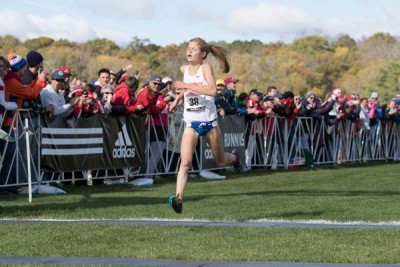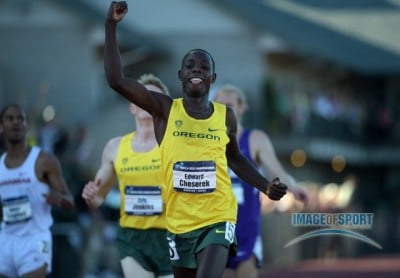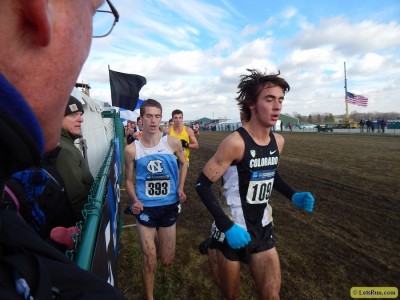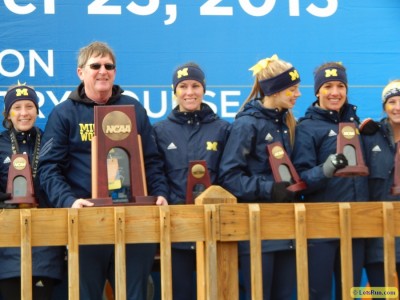NCAA XC Weekend Recap: Ches Goes Down (But He Shouldn’t Be Worried), Hail to the Victors and a Wide-Open Women’s Individual Race
By LetsRun.com
October 19, 2015
The major invitationals of the 2015 NCAA cross country season are behind us, and the championship portion of the schedule approaches: conferences, regionals and, on November 21, NCAAs. Before we look ahead, though, let’s look back at this past weekend’s action. On Friday in Madison, Wis., the No. 1 New Mexico women (32 points) and No. 2 Syracuse men (101 points) both earned commanding wins, with Boise State true freshman Allie Ostrander (19:19 course record) and Tulsa senior Marc Scott (23:35) claiming the individual titles.
We recapped the major goings-on in Wisconsin on Friday, so this column will mostly focus on Pre-Nats, which took place in Louisville on Saturday. On the course that will host nationals less than five weeks from now, the No. 1 Colorado men (89 points) and No. 5 Michigan women (131 points) took home the team titles with Virginia Tech’s Thomas Curtin (23:18) and Colorado’s Erin Clark (20:00) winning the individual races.
You can find results from the major meets below, followed by our six takeaways from the weekend.
Wisconsin adidas Invitational * Pre-Nats * Princeton Invitational * All weekend results
1. Edward Cheserek loses a cross country race
Edward Cheserek is blessed with a rare blend of endurance and top-end speed that makes him all but invincible in a championship race. In his first two years at the University of Oregon, Cheserek has won eight individual NCAA titles and anchored the winning DMR at NCAA indoors this year. Only two men have ever defeated him at a conference/NCAA championship: Lawi Lalang (who at the time owned PRs of 3:33 and 13:00) and Eric Jenkins (who would run 13:07 four months later). So when Cheserek loses a race, any race, it feels like a major event.
But not all races are created equal. A ‘loss’ at the Stanford Invitational, where Cheserek has earned NCAA qualifying times each of the past two years, means less than a loss at the NCAA West Regional, which in turn means less than a loss at the Penn Relays. So what to make of Cheserek’s latest loss, a four-second defeat to Virginia Tech’s Thomas Curtin at Pre-Nationals on Saturday?
First, let’s start by handing congratulations to Curtin. Cheserek’s opponents rarely opt to push the pace as few believe they will be able to create enough separation (or tire out Cheserek enough) to nullify his kick at the end of a race. Curtin showed no fear on Saturday, charging out to the lead alone and building a massive lead by five kilometers. Cheserek and the rest of the chase pack waited too long to try to narrow the gap, and they ran out of grass as Curtin posted a four-second victory. Curtin’s victory was well-earned, and you can read more about him in our Q&A with him here: LRC Q&A with Thomas Curtin, the Tea-Drinking, Bandana-Wearing Virginia Tech Senior Who Took Down Edward Cheserek at Pre-Nats
Cheserek told Flotrack after the race “our goal was just to see the course. [We] weren’t even trying to go for the win.” We don’t fully buy that. If Cheserek’s only goal was to see the course, he wouldn’t have tried to run Curtin down at the end and wouldn’t have bothered to hold off UTEP’s Anthony Rotich for second in the race. Cheserek clearly would have been more vigilant if Saturday’s race was NCAAs rather than Pre-Nats, but to say he wasn’t trying to go for the win is tiny bit disrespectful of what Curtin accomplished. Curtin’s win reminds us of Meb Keflezighi‘s win at the Boston Marathon in 2014. The Ethiopians and Kenyans in Boston wanted to win – they just didn’t take Meb’s move seriously and spotted him to much of a lead. The same is true here.
Cheserek’s defeat on Saturday naturally leads to a question: does this mean Cheserek can be beaten at NCAAs? While anyone can be beaten, the answer likely remains no. In fact, Cheserek may have an even greater chance of winning after this weekend’s race. That seems illogical — the guy just got beat, so how could his odds possibly improve? — but consider how Pre-Nats played out. Curtin dropped the field early and created an insurmountable lead. By the time Cheserek tried to close the gap, it was too late.
If you were to draw up a game plan of how to beat Cheserek, Curtin’s would be one of the best strategies: get out hard, hope he doesn’t take you seriously and gain a large enough lead to hold off Cheserek’s inevitable kick. But how likely is it that that game plan will work twice in one season? Now Cheserek will be hyper-sensitive to anyone making an aggressive move early in the race. The chances of anyone catching him off guard and amassing a 12-second lead, as Curtin did in Louisville, are essentially zero.
Really, Pre-Nats did little to change the NCAA championship picture. Apart from Curtin, Cheserek outkicked everyone else in the field. He remains the same dominating runner he was before the race, except he is now aware of one of his vulnerabilities. Curtin is certainly a top-10 threat, but given how convincingly Cheserek has beaten him in the past (Cheserek was 2nd in the NCAA indoor 3k to Curtin’s 8th; Cheserek won the NCAA outdoor 5k while Curtin was 7th), he will still be a sizable underdog when they meet again in Louisville in five weeks. Discount Cheserek at your own peril.
2. Colorado wins Pre-Nats (again). Where’s Ben Saarel?
The No. 1 Colorado men won their fifth straight title at Pre-Nats on Saturday, scoring 89 points to win comfortably over No. 3 Oregon (151). The Buffaloes got a great race out of Pierce Murphy (5th overall) and solid ones from Connor Winter (9th), Ammar Moussa (14th) and Mogan Pearson (15th), all of whom finished in the top 15.
However, unlike last year, when CU scored 35 points at Pre-Nats, Colorado showed some vulnerability at the #5 spot, relying on true freshman John Dressel. Dressel, the Foot Locker runner-up in 2013 as a junior, was 46th overall. The Buffaloes have become so dominant in recent years that even a minor flaw like this can be blown out of proportion.
So let’s keep it in proportion. Dressel was the first #5 runner across the line in Louisville; in fact, CU’s #6, redshirt freshman Ryan Forsyth (51st), beat everyone else’s #5 except for Arkansas’. And Colorado’s #7, sophomore Zach Perrin, who was their #4 guy in their opening meet, beat the #5 runner of every team save Arkansas and Oregon. And apparently Dressel fell at the start of the race (according to Pearson’s interview with Flotrack).
As currently constructed, Colorado is not better than last year’s title team — what coach Mark Wetmore described as the best squad in school history — but Colorado doesn’t need to be better than last year’s team to win the national title. They just need to be better than every other school in 2015. And in that department, they’re doing just fine. In 2013, CU scored an almost identical total at Pre-Nats (90 to 89) and went on to win NCAAs.
The biggest question about Colorado is the status of Ben Saarel. Saarel, who has finished 8th and 7th at NCAAs the past two years, raced at the Rocky Mountain Shootout on October 3 but was well behind CU’s top athletes, finishing as the team’s sixth man in 25:18 (for reference, Murphy ran 24:26, Pearson 24:31 and Winter 24:35). Wetmore said Saarel’s performance there was the result of a cold, but it was also worth noting he competed unattached. Then on Saturday, Saarel didn’t race at all.
Pearson told Flotrack that Saarel is coming back from sickness and that Wetmore was just being cautious by not racing him. That’s good news for CU fans — after all, Saarel battled a virus for most of last fall before taking seventh at NCAAs. However, it is possible, if Saarel isn’t totally back to 100%, that Wetmore would elect to keep the redshirt on him. Wetmore did the same thing with Pearson last year and it worked like a charm, but this CU team isn’t as deep through five men as last year’s edition (without Pearson, the 2014 Buffs still had five studs; without Saarel, the 2015 Buffs have four), so redshirting Saarel would carry more risk (Wetmore did not respond to an interview request from LRC on Monday).
If Saarel runs at NCAAs, Colorado should have no problem defending their team title. Wetmore wouldn’t race him if he didn’t think he could have an impact, and Saarel’s track record at NCAAs is impeccable. Add in a terrific top four and Saarel would likely need only finish in the top 40 or 50 to deliver Colorado its third straight title.
Take him out of the equation, and things become more interesting. No. 2 Syracuse ran extremely well at Wisconsin, and with three guys in the top six there, Cuse matches up very well with Colorado through three. CU has a big edge at #4, so it would come down to Syracuse making up ground at #5; a possibility if Dan Lennon runs more like he did in 2014-15 (45th at NCAAs, 28:46 on the track) than he did last week at Wisconsin (their #5 man – just 61st at Wisconsin).
The good news for Colorado fans is they can find out if they are vulnerable at #5 in two weeks at Pac 12s as Dressel will get to face some top-notch competition and presumably won’t fall.
MB: Syracuse 2015 version is way better than the 2014 version
Without Saarel at 100%, Colorado are certainly more vulnerable to a loss at NCAAs than Cheserek. But until further notice, the Buffs are still the favorites at NCAAs. Dressel and Forsyth may be freshmen, but they ran impressive races at Pre-Nats and now have big-race experience on the NCAA course. We’ll know more about the Buffaloes after Pac-12s — where they should face a full-strength Stanford team.
[raw]
[/raw]
3. Will the real Stanford please stand up?
What Stanford has done this year — racing its top athletes sparingly — shouldn’t come as a surprise. When we spoke to Cardinal head coach Chris Miltenberg at the start of the season, he said that his plan was to bring his runners along slowly, especially those whose track season stretched into June/July. It’s an approach that paid off last year, as the Stanford men finished second at NCAAs, their best result since the Cardinal won it all in 2003.
While that strategy may be the best for Stanford in the long run, it makes it difficult to get a read on how good the Cardinal men and women really are. We should get a look at Stanford’s full squads at Pac-12s on October 30. Hopefully after that race, we’ll have the answers to the following questions.
- Will Jim Rosa race? According to Stanford’s website, Rosa is working his way back from an injury. When healthy, he’s a game-changer. He was 5th at NCAA XC two years ago, but Rosa hasn’t run a cross race since then. Stanford possibly could get on the podium without him, but to challenge Colorado, they’ll need Rosa fit and close to top form. Rosa doesn’t have any cross eligibility remaining after this year, so he’ll be making every effort race this fall (it’s possible he could petition the NCAA for a sixth year, but that’s far from a guarantee). Whether he races at Pac-12s — and how he does — will set the expectations for the Cardinal at NCAAs.
- Will Grant Fisher redshirt? Miltenberg said at the start of the year if Fisher is to race in a Cardinal uniform, it likely wouldn’t come until Pac-12s. If Fisher is healthy and still training well (he ran a great debut race unattached at the Stanford Invite on September 26), he should race Pac-12s. It’s not complicated: a healthy Fisher makes Stanford a better team.
- Can Sam Wharton return to his 2014 form? Wharton spent the summer/early fall recovering from a stress fracture and made his season debut on Friday at Wisconsin, where he finished 200th overall. Obviously it’s good for Stanford that Wharton is racing again, and he made a big jump from Wisconsin (123rd) to NCAAs (39th) last year. But going from 200th at Wisconsin to a factor at NCAAs is a tough ask, even from someone as talented as Wharton (he was the 2012 NXN champ in high school).
- How serious is the injury to Elise Cranny? Cranny has yet to race this fall and is working through an injury and trying to return by the end of the season, per Stanford’s website. It will be interesting to see how Miltenberg plays this one. The Stanford women are not a national title threat – their best-case scenario is the podium, though that only happens if Cranny, who was 12th last year as a true freshman, is near her best. Considering Cranny hasn’t redshirted yet in her career, Miltenberg will likely be more cautious with her than he would with Rosa/Wharton.
- Is everything all right with Aisling Cuffe? Cuffe didn’t run Pre-Nats as an “injury precaution” according to Stanford’s website. That obviously means she’s doing better than Cranny (whom Stanford admitted is injured) but it’s still vague. Is Cuffe, who won the Washington Invitational on October 2, banged up? Or did Miltenberg not want to expose her to the extra stress of racing (Miltenberg did not respond to LRC’s interview request on Monday). Cuffe’s situation seems less serious than Rosa or Cranny, but we’ll only know for sure once Pac-12s rolls around. Until then, we play the waiting game.
MB: No Rosa, Rosa, Fisher for Stanford- Are they healthy?
4. Hail to the Victors — the Michigan women get it done
Last year was supposed to be the year in Ann Arbor. Boasting a top seven consisting entirely of Michigan natives, the Wolverines were the top-ranked team in the preseason coaches’ poll (and LRC’s rankings). But what began as a dream season wound up as a nightmare. Michigan’s top two runners, Erin Finn and Shannon Osika, were forced to end their season prematurely due to injuries, and the Wolverines slid to 18th at NCAAs. Even worse, in-state rival Michigan State accomplished what UM could not and won its first NCAA title.
Expectations at Michigan were not as high entering 2015 (the Wolverines began the year ranked 12th in the coaches’ poll and ninth in LRC’s rankings) but with Finn and Osika healthy once again, this year’s squad is working to eliminate the sour taste the 2014 season left in everyone’s mouth. Those two led the way for Big Blue at Pre-Nats, finishing 6th and 13th, respectively as the Wolverines took down No. 2 Colorado and No. 4 Oregon to earn the team title with 131 points.
The key runners for Michigan on Saturday were a pair of sophomores, Gina Sereno and Jaimie Phelan. Though both ran at Pre-Nats last year as redshirt freshmen, they did so in the open race. But both were thrust into the top seven after Finn and Osika went down, and the experience they gained at the big end-of-season meets is paying dividends now. Sereno took 35th on Saturday, finishing as UM’s #3 woman, while Phelan was three seconds back in 38th.
The national title is spoken for (it would take a monumental upset for New Mexico to lose at NCAAs, though the Lobos still have to make it to the line healthy) but the other three podium spots are very much up for grabs, and after last weekend, Michigan has the strongest case for #2.
5. We still have no idea who will win the women’s individual title at NCAAs
Ideally, between Wisconsin and Pre-Nats, we’d have an answer about who is the favorite for the women’s individual title at NCAAs next month. Instead, this weekend produced more questions than answers. Freshman Ryen Frazier, who many pegged as a top contender after her victory at the Notre Dame Invitational on October 2, was only 38th at Wisconsin, where fellow first-year Allie Ostrander of Boise State asserted herself with a victory in a blazing 19:19, smashing the course record of Dartmouth’s Abbey D’Agostino, set in her NCAA-winning season of 2013.
 Ostrander is one of several women in a crowded field of NCAA contenders (photo courtesy Boise State XC)
Ostrander is one of several women in a crowded field of NCAA contenders (photo courtesy Boise State XC)
Ostrander’s performance was undoubtedly impressive, perhaps the best of the 2015 season, but she also lost to Cal’s Bethan Knights at Roy Griak on September 26 by 16 seconds. Cal made the trip out to Louisville, but Knights did not race. Nor did her rival from across San Francisco Bay, Aisling Cuffe of Stanford, who sat out Pre-Nats after winning the Washington Invitational on October 2. Instead, the victory went to another Pac-12 runner, Erin Clark of Colorado, who kicked away from Air Force’s Hannah Everson and Tennessee’s Chelsea Blaase to win in a relatively slow 20:00.
Clark must now be taken seriously as a threat for the individual title. Her 20:13 at the Rocky Mountain Shootout earlier this season was 41 seconds ahead of second and is the #2 time on the course in the past 14 years, behind only Jenny Simpson. Clark, Knights and Cuffe will all clash at Pac-12s on October 30, and the winner there will like her chances at NCAAs. But there are a ton of other contenders, including NCAA champs Molly Seidel of Notre Dame and Dominique Scott of Arkansas (2nd and 3rd at Wisconsin). And it’s entirely possible that one of New Mexico’s Fab Four, such as Courtney Frerichs or Rhona Auckland, could be a threat if coach Joe Franklin lets them loose at NCAAs.
The next few weeks will tell us a lot. Remember, at this point last season, Kate Avery of Iona hadn’t even raced yet, but by NCAAs she had emerged as the favorite and backed that up with a win in Terre Haute.
6. The Arkansas men keep rolling, Ole Miss is Struggling
Arkansas has claimed 22 of the last 24 SEC men’s cross country titles, including the last five in a row. Many (including us) expected that streak to come to an end in 2015. The Razorbacks finished just 28th at NCAAs last year and aside from the now-departed Stanley Kebenei, no one on their team finished in the top 150 overall. Meanwhile, 400 miles east, Ole Miss assembled a powerful roster of transfers. The Rebels lost to Arkansas by six at SECs last year and seemed poised to earn their first SEC title this fall.
But the Razorbacks appear reluctant to hand over their crown. No. 13 Arkansas finished third at Pre-Nats, losing only to Colorado and Oregon (two of the country’s top three teams according to the coaches’ poll) and taking down foes such as No. 10 Georgetown and No. 13 UTEP. And that performance came in spite of a bad day from Alex George (8:02/13:51 PBs), the Razorback’s top man at the Chile Pepper Invitational who was only their #5 (50th overall) on Saturday.
Arkansas doesn’t have a front-of-the pack stud like Kemoy Campbell or Stanley Kebenei, but it makes up for that in depth as all five scoring runners finished in the top 50 (Colorado was the only other team to do that on Saturday), with a spread of under 20 seconds.
Ole Miss on the other hand hand had a horrible weekend – finishing 24th at Wisconsin. Unless they turn that around, Chris Bucknam‘s men should take home yet another SEC title to Fayetteville in two weeks.
7. Trouble for Villanova
Villanova placed seventh at NCAAs last year, the program’s best finish since 2000, and entered 2015 ranked seventh in the USTFCCCA coaches’ poll and fifth in our preseason rankings. Those projections are starting to look optimistic. In the Wildcats’ first big test, at Paul Short two weeks ago, they went 1-2-4 but finished second to Georgetown mainly because fifth man Kevin Corbusier was 39th overall (Georgetown had nine in the top 28 in a shallow field).
Saturday’s Princeton Invitational was the same story. Patrick Tiernan, Jordy Williamsz and Rob Denault went 1-2-3 for Nova, but they lost to unranked Penn as #4 man Harry Warnick and #5 man Corbusier were just 21st and 24th.
For Villanova to better last year’s finish, Warnick and Corbusier needed to step up for the departed Brian Basili and Sam McEntee, and so far that hasn’t happened. That’s not a knock on Warnick and Corbusier, but rather a reminder that it’s not always easy to reload when you lose key guys. At programs like Colorado, Wisconsin and Iona, it seems like talent comes off an assembly line; those squads reload and are competitive every year. What’s happened to Villanova so far this season is more typical; most teams go through good and bad patches.
With a stacked top three, Nova can still turn it around and place in the top 10 at NCAAs with a strong run on the day. But they’re also in danger of missing the meet entirely. By passing up Wisconsin/Pre-Nats, Villanova cost itself a shot at at-large points, meaning it now has to earn them at Big Easts (beating Georgetown will help; beating Providence could) or finish in the top two at the Mid-Atlantic Regional, which would require turning the tables on Georgetown or Penn — the two teams that have beaten them this year.




